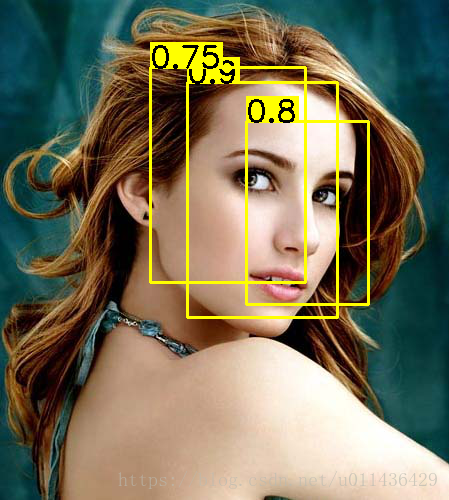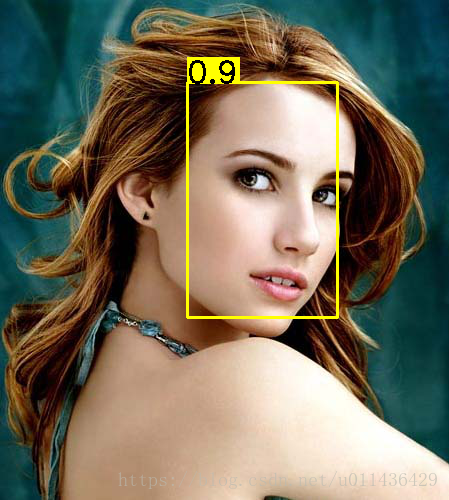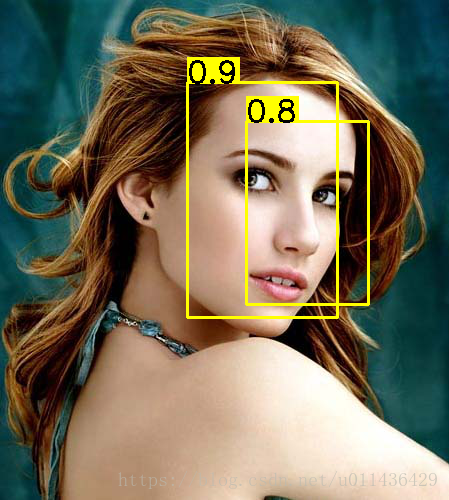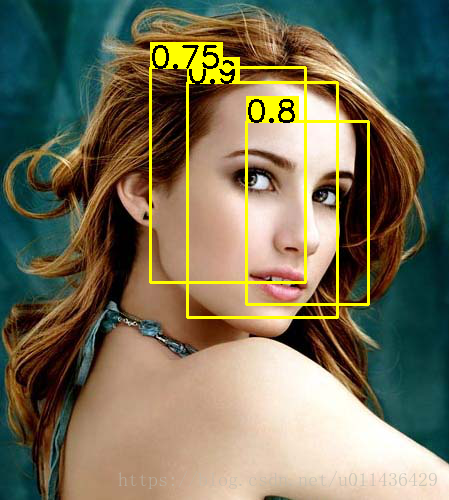首先选定一个IOU阈值,例如为0.4。然后将所有3个窗口(bounding box)按照得分由高到低排序。然后选中得分最高的窗口,遍历计算剩余的2个窗口与该窗口的重叠面积比例(IOU),如果IOU大于阈值0.4,则将窗口删除。然后,再从剩余的窗口中选中一个得分最高的,重复上述过程。直至所有窗口都被处理。
假定这张图片上有3个候选框,如下图所示

那么如果IOU阀值设置为0.4后最终结果为

如果IOU阀值设置为0.5后最终结果为

如果IOU阀值设置为0.6后最终结果为

由此可见IOU 阀值的设置需要实验来衡量的。
下面是python实现代码
#!/usr/bin/env python
# _*_ coding: utf-8 _*_
import cv2
import numpy as np
"""
Non-max Suppression Algorithm
@param list Object candidate bounding boxes
@param list Confidence score of bounding boxes
@param float IoU threshold
@return Rest boxes after nms operation
"""
def nms(bounding_boxes, confidence_score, threshold):
# If no bounding boxes, return empty list
if len(bounding_boxes) == 0:
return [], []
# Bounding boxes
boxes = np.array(bounding_boxes)
# coordinates of bounding boxes
start_x = boxes[:, 0]
start_y = boxes[:, 1]
end_x = boxes[:, 2]
end_y = boxes[:, 3]
# Confidence scores of bounding boxes
score = np.array(confidence_score)
# Picked bounding boxes
picked_boxes = []
picked_score = []
# Compute areas of bounding boxes
areas = (end_x - start_x + 1) * (end_y - start_y + 1)
# Sort by confidence score of bounding boxes
order = np.argsort(score)
# Iterate bounding boxes
while order.size > 0:
# The index of largest confidence score
index = order[-1]
# Pick the bounding box with largest confidence score
picked_boxes.append(bounding_boxes[index])
picked_score.append(confidence_score[index])
a=start_x[index]
b=order[:-1]
c=start_x[order[:-1]]
# Compute ordinates of intersection-over-union(IOU)
x1 = np.maximum(start_x[index], start_x[order[:-1]])
x2 = np.minimum(end_x[index], end_x[order[:-1]])
y1 = np.maximum(start_y[index], start_y[order[:-1]])
y2 = np.minimum(end_y[index], end_y[order[:-1]])
# Compute areas of intersection-over-union
w = np.maximum(0.0, x2 - x1 + 1)
h = np.maximum(0.0, y2 - y1 + 1)
intersection = w * h
# Compute the ratio between intersection and union
ratio = intersection / (areas[index] + areas[order[:-1]] - intersection)
left = np.where(ratio < threshold)
order = order[left]
return picked_boxes, picked_score
# Image name
image_name = 'nms.jpg'
# Bounding boxes
bounding_boxes = [(187, 82, 337, 317), (150, 67, 305, 282), (246, 121, 368, 304)]
confidence_score = [0.9, 0.75, 0.8]
# Read image
image = cv2.imread(image_name)
# Copy image as original
org = image.copy()
# Draw parameters
font = cv2.FONT_HERSHEY_SIMPLEX
font_scale = 1
thickness = 2
# IoU threshold
threshold = 0.4
# Draw bounding boxes and confidence score
for (start_x, start_y, end_x, end_y), confidence in zip(bounding_boxes, confidence_score):
(w, h), baseline = cv2.getTextSize(str(confidence), font, font_scale, thickness)
cv2.rectangle(org, (start_x, start_y - (2 * baseline + 5)), (start_x + w, start_y), (0, 255, 255), -1)
cv2.rectangle(org, (start_x, start_y), (end_x, end_y), (0, 255, 255), 2)
cv2.putText(org, str(confidence), (start_x, start_y), font, font_scale, (0, 0, 0), thickness)
# Run non-max suppression algorithm
picked_boxes, picked_score = nms(bounding_boxes, confidence_score, threshold)
# Draw bounding boxes and confidence score after non-maximum supression
for (start_x, start_y, end_x, end_y), confidence in zip(picked_boxes, picked_score):
(w, h), baseline = cv2.getTextSize(str(confidence), font, font_scale, thickness)
cv2.rectangle(image, (start_x, start_y - (2 * baseline + 5)), (start_x + w, start_y), (0, 255, 255), -1)
cv2.rectangle(image, (start_x, start_y), (end_x, end_y), (0, 255, 255), 2)
cv2.putText(image, str(confidence), (start_x, start_y), font, font_scale, (0, 0, 0), thickness)
# Show image
cv2.imshow('Original', org)
cv2.imshow('NMS', image)
cv2.waitKey(0)

后记:关于NMS的一些思考
Q:针对图像候选框 有nms 处理方法,是抛弃iou大于阈值某个数的候选框后, 留最后一个.如果把置信度大于某个阀值的候选框保留,最大化剩下的候选框(就是把大于阀值的候选框进行融合取并集) ,这样能够显示出对象的最大bbox,会不会更好?
A:不行,因为如果只是检测没什么问题,但后续会把检测出来的bbox 送到分类器进行分类,这样就没法处理了(因为最大化bbox 后一个候选框可能有多个对象,没法进行分类了)





















 270
270

 被折叠的 条评论
为什么被折叠?
被折叠的 条评论
为什么被折叠?








